engine TOYOTA RAV4 PLUG-IN HYBRID 2021 User Guide
[x] Cancel search | Manufacturer: TOYOTA, Model Year: 2021, Model line: RAV4 PLUG-IN HYBRID, Model: TOYOTA RAV4 PLUG-IN HYBRID 2021Pages: 666, PDF Size: 161.28 MB
Page 93 of 666
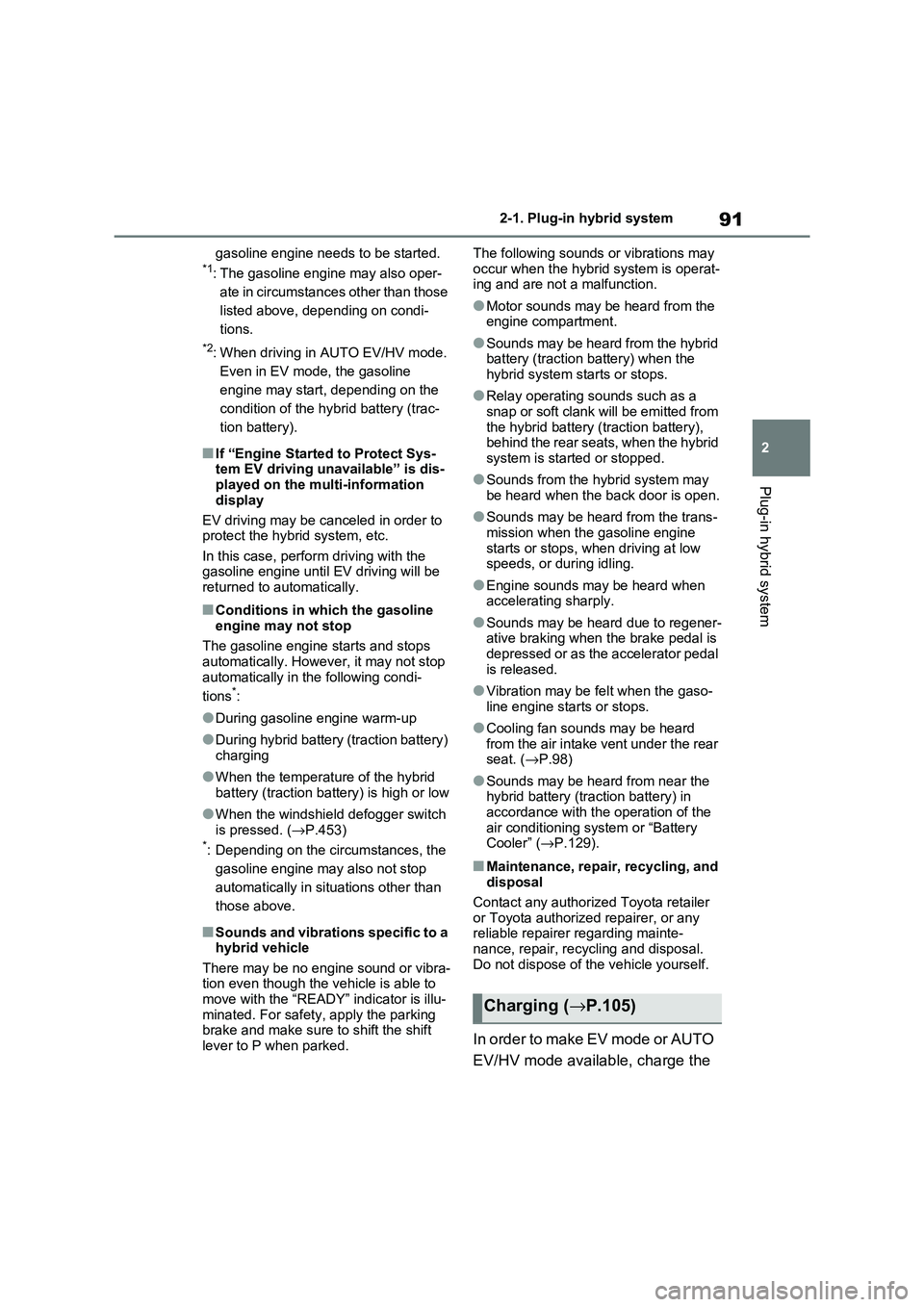
91
2
2-1. Plug-in hybrid system
Plug-in hybrid system
gasoline engine needs to be started.*1: The gasoline engine may also oper -
ate in circumstances other than those
listed above, depending on condi -
tions.
*2: When driving in AUTO EV/HV mode.
Even in EV mode, the gasoline
engine may start, depending on the
condition of the hybrid battery (trac -
tion battery).
■If “Engine Started to Protect Sys -
tem EV driving unavailable” is dis - played on the mu lti-information
display
EV driving may be canceled in order to protect the hybr id system, etc.
In this case, perform driving with the
gasoline engine until EV driving will be returned to automatically.
■Conditions in which the gasoline
engine may not stop
The gasoline engine starts and stops automatically. Howev er, it may not stop
automatically in the following condi -
tions*:
●During gasoline engine warm-up
●During hybrid battery (traction battery)
charging
●When the temperature of the hybrid
battery (traction batt ery) is high or low
●When the windshield defogger switch
is pressed. ( →P.453)*: Depending on the circumstances, the
gasoline engine may also not stop
automatically in sit uations other than
those above.
■Sounds and vibrations specific to a
hybrid vehicle
There may be no engine sound or vibra - tion even though the vehicle is able to
move with the “READY” indicator is illu-
minated. For safety, apply the parking brake and make sure to shift the shift
lever to P when parked.
The following sounds o r vibrations may
occur when the hyb rid system is operat- ing and are not a malfunction.
●Motor sounds may be heard from the engine compartment.
●Sounds may be heard from the hybrid battery (traction battery) when the
hybrid system starts or stops.
●Relay operating sounds such as a
snap or soft clank will be emitted from
the hybrid battery ( traction battery), behind the rear seats, when the hybrid
system is started or stopped.
●Sounds from the hy brid system may
be heard when the back door is open.
●Sounds may be heard from the trans -
mission when the gasoline engine
starts or stops, when driving at low speeds, or during idling.
●Engine sounds may be heard when accelerating sharply.
●Sounds may be heard due to regener - ative braking when t he brake pedal is
depressed or as the accelerator pedal
is released.
●Vibration may be f elt when the gaso-
line engine starts or stops.
●Cooling fan sounds may be heard
from the air intake vent under the rear seat. ( →P.98)
●Sounds may be heard from near the hybrid battery (traction battery) in
accordance with th e operation of the
air conditioning syst em or “Battery Cooler” ( →P.129).
■Maintenance, repair, recycling, and
disposal
Contact any authoriz ed Toyota retailer
or Toyota authorized repairer, or any reliable repairer regarding mainte -
nance, repair, recycling and disposal.
Do not dispose of the vehicle yourself.
I n o r d e r t o m a k e E V m o d e o r A U T O
EV/HV mode available, charge the
Charging ( →P.105)
Page 94 of 666
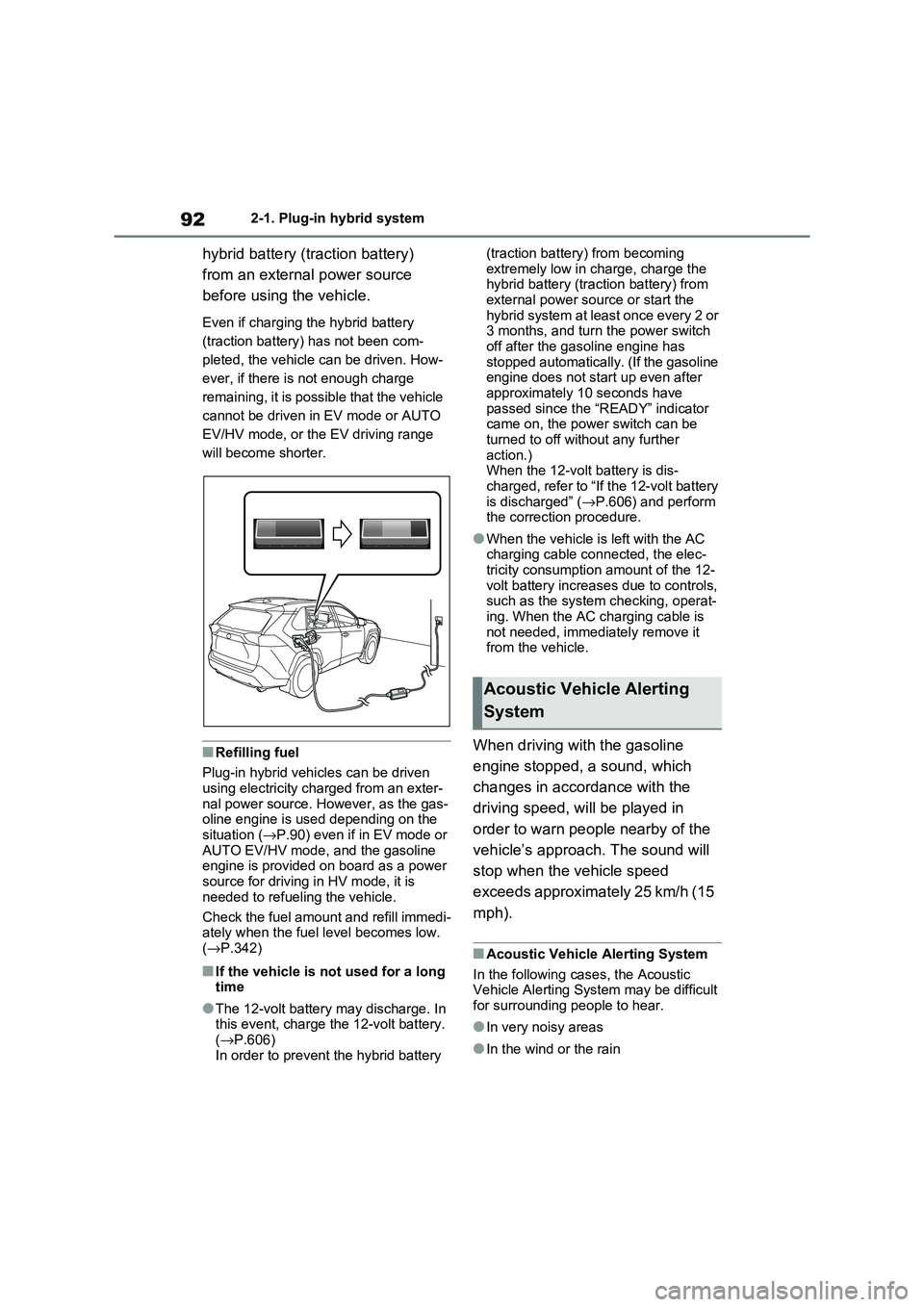
922-1. Plug-in hybrid system
hybrid battery (traction battery)
from an external power source
before using the vehicle.
Even if charging t he hybrid battery
(traction battery) has not been com-
pleted, the vehicle can be driven. How -
ever, if there is not enough charge
remaining, it is possible that the vehicle
cannot be driven in EV mode or AUTO
EV/HV mode, or the EV driving range
will become shorter.
■Refilling fuel
Plug-in hybrid vehicl es can be driven
using electricity charged from an exter -
nal power source. However, as the gas - oline engine is used depending on the
situation ( →P.90) even if in EV mode or
AUTO EV/HV mode, and the gasoline engine is provided on board as a power
source for driving in HV mode, it is
needed to refueling the vehicle.
Check the fuel amount and refill immedi -
ately when the fuel level becomes low.
( →P.342)
■If the vehicle is not used for a long
time
●The 12-volt battery may discharge. In
this event, charge t he 12-volt battery. ( →P.606)
In order to prevent t he hybrid battery
(traction battery) from becoming
extremely low in c harge, charge the hybrid battery (trac tion battery) from
external power source or start the
hybrid system at least once every 2 or 3 months, and turn the power switch
off after the gasoline engine has
stopped automatically. (If the gasoline engine does not sta rt up even after
approximately 10 seconds have
passed since the “READY” indicator came on, the power switch can be
turned to off without any further
action.) When the 12-volt battery is dis -
charged, refer to “If the 12-volt battery
is discharged” ( →P.606) and perform the correction procedure.
●When the vehicle is left with the AC charging cable co nnected, the elec-
tricity consumption amount of the 12-
volt battery increas es due to controls, such as the system checking, operat-
ing. When the AC charging cable is
not needed, immediately remove it from the vehicle.
When driving with the gasoline
engine stopped, a sound, which
changes in accord ance with the
driving speed, wil l be played in
order to warn people nearby of the
vehicle’s approach. The sound will
stop when the vehicle speed
exceeds approximately 25 km/h (15
mph).
■Acoustic Vehicle Alerting System
In the following cases, the Acoustic
Vehicle Alerting System may be difficult for surrounding people to hear.
●In very noisy areas
●In the wind or the rain
Acoustic Vehicle Alerting
System
Page 100 of 666
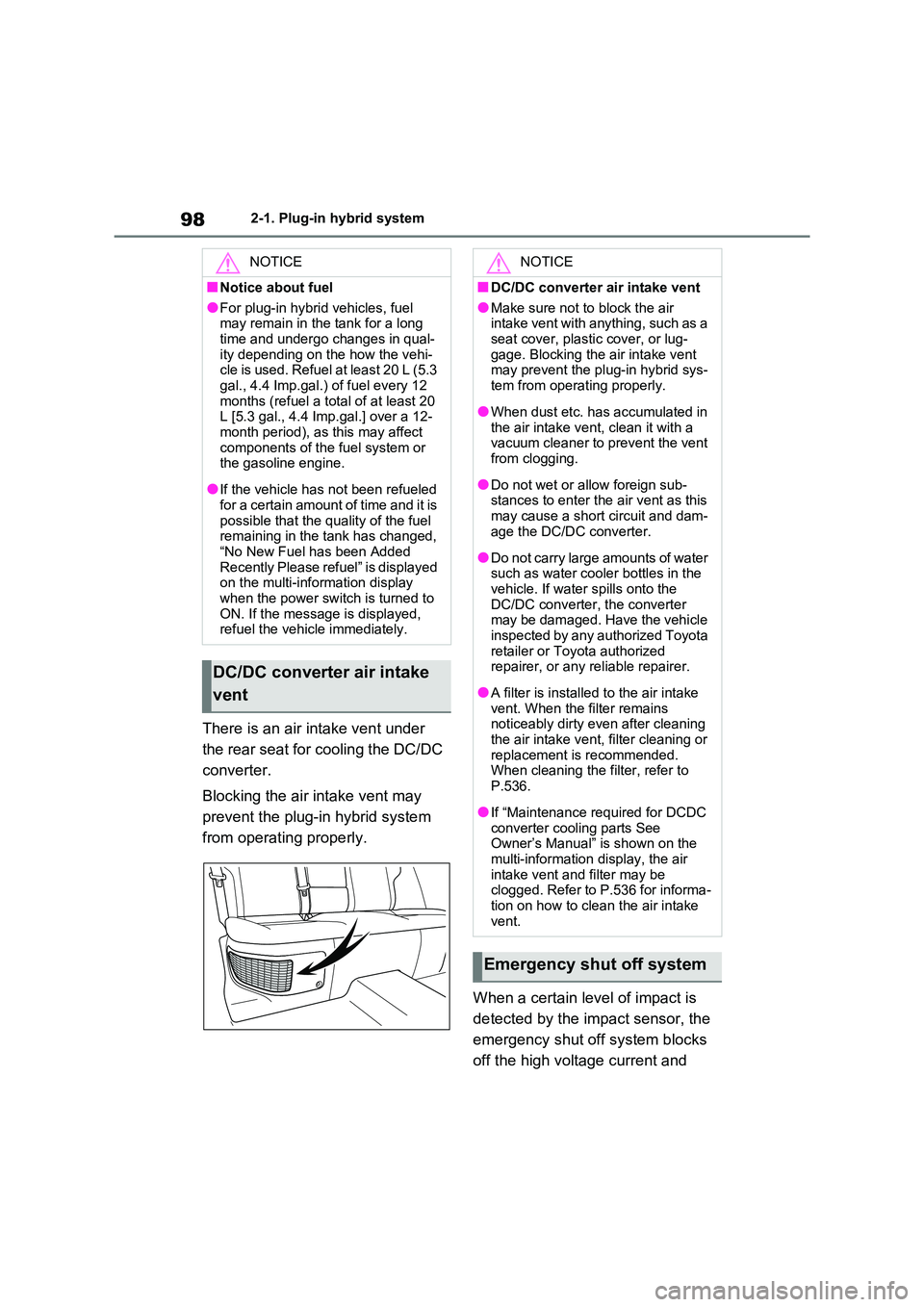
982-1. Plug-in hybrid system
There is an air intake vent under
the rear seat for cooling the DC/DC
converter.
Blocking the air intake vent may
prevent the plug-in hybrid system
from operating properly.
When a certain level of impact is
detected by the im pact sensor, the
emergency shut off system blocks
off the high voltage current and
NOTICE
■Notice about fuel
●For plug-in hybrid vehicles, fuel
may remain in the tank for a long time and undergo changes in qual -
ity depending on the how the vehi -
cle is used. Refuel at least 20 L (5.3 gal., 4.4 Imp.gal. ) of fuel every 12
months (refuel a tot al of at least 20
L [5.3 gal., 4.4 Imp.gal.] over a 12-
month period), as this may affect components of the fuel system or
the gasoline engine.
●If the vehicle has not been refueled
for a certain amount of time and it is
possible that the quality of the fuel remaining in the tank has changed,
“No New Fuel has been Added
Recently Please refuel” is displayed on the multi-information display
when the power switch is turned to
ON. If the message is displayed, refuel the vehicle immediately.
DC/DC converter air intake
vent
NOTICE
■DC/DC converter air intake vent
●Make sure not to block the air
intake vent with anything, such as a seat cover, plastic cover, or lug -
gage. Blocking the air intake vent
may prevent the plug-in hybrid sys - tem from operating properly.
●When dust etc. has accumulated in
the air intake ven t, clean it with a vacuum cleaner to prevent the vent
from clogging.
●Do not wet or a llow foreign sub-
stances to enter the air vent as this
may cause a shor t circuit and dam- age the DC/DC converter.
●Do not carry large amounts of water such as water cooler bottles in the
vehicle. If water spills onto the
DC/DC converter, the converter may be damaged. Have the vehicle
inspected by any authorized Toyota
retailer or Toyota authorized repairer, or any reliable repairer.
●A filter is installed to the air intake vent. When the filter remains
noticeably dirty even after cleaning
the air intake vent, filter cleaning or replacement is recommended.
When cleaning the filter, refer to
P.536.
●If “Maintenance required for DCDC
converter cooling parts See Owner’s Manual” is shown on the
multi-information display, the air
intake vent and filter may be clogged. Refer to P.536 for informa -
tion on how to clean the air intake
vent.
Emergency shut off system
Page 102 of 666

1002-1. Plug-in hybrid system
Shift the shift lever to D when
stopped at a traffic light, or driving
in heavy traffic etc. Shift the shift
lever to P when parking. When
using the N, there is no positive
effect on fuel consumption. In the
N, the gasoline engine operates but
electricity canno t be generated.
Also, when using the air condition -
ing system, etc., the hybrid battery
(traction battery) power is con -
sumed.
Drive your vehicle smoothly.
Avoid abrupt acceleration and
deceleration. Gradual accelera -
tion and deceler ation will make
more effective use of the electric
motor (traction motor) without
having to use gasoline engine
power.
Avoid repeated acceleration.
Repeated acceleration con -
sumes hybrid battery (traction
battery) power, resulting in poor
fuel consumption. Battery power
can be restored by driving with
the accelerator pedal slightly
released.
Make sure to operate the brakes
gently and a ti mely manner. A
greater amount of electrical energy
can be regenerated when slowing
down.
Repeated acceler ation and decel-
eration, as well as long waits at traf -
fic lights, will lead to high fuel and
electricity consumption. Check traf -
fic reports before leaving and avoid
delays as much as possible. When
driving in a traffic jam, gently
release the brake pedal to allow the
vehicle to move forward slightly
while avoiding overuse of the accel -
erator pedal. Doing so can help
control excessive electricity and
fuel consumption.
Control and maintain the vehicle
at a constant speed. Before stop -
ping at a toll booth or similar,
allow plenty of time to release
the accelerator and gently apply
the brakes. A greater amount of
electrical energy can be regener -
ated when slowing down.
Electricity consumption will
increase significantly when driv -
ing at high speeds in EV mode or
AUTO EV/HV mode. If there will
be a long distance to the next
external charging point after
leaving a freewa y, it is recom-
mended to drive in HV mode
while on the freeway and change
Shift lever operation
Accelerator pedal/brake
pedal operation
When braking
Delays
Highway driving
Page 103 of 666
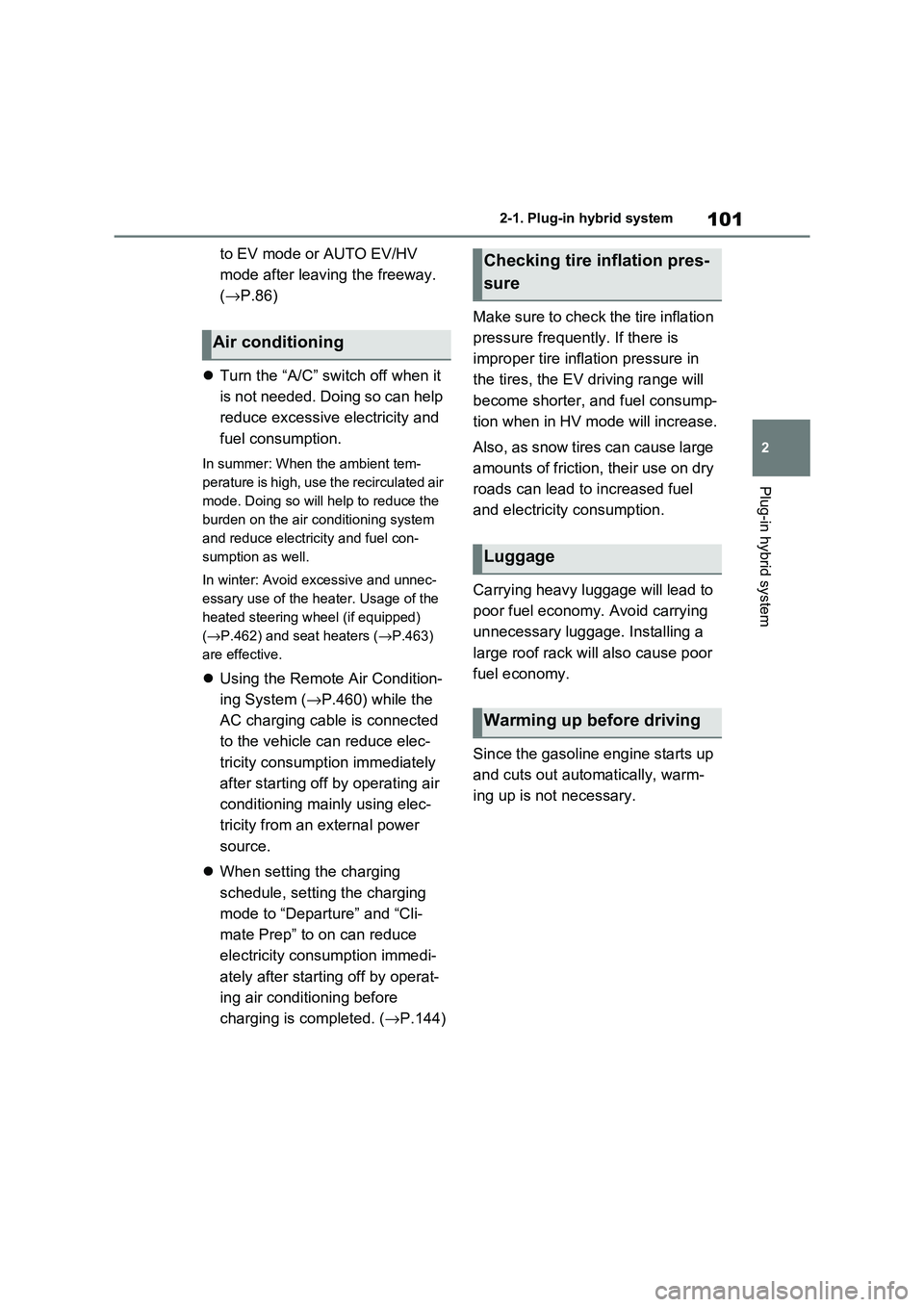
101
2
2-1. Plug-in hybrid system
Plug-in hybrid system
to EV mode or AUTO EV/HV
mode after leaving the freeway.
( →P.86)
Turn the “A/C” switch off when it
is not needed. Doing so can help
reduce excessive e lectricity and
fuel consumption.
In summer: When the ambient tem -
perature is high, use the recirculated air
mode. Doing so will help to reduce the
burden on the air co nditioning system
and reduce electricity and fuel con -
sumption as well.
In winter: Avoid excessive and unnec-
essary use of the heater. Usage of the
heated steering w heel (if equipped)
( →P.462) and seat heaters (→P.463)
are effective.
Using the Remote Air Condition-
ing System ( →P.460) while the
AC charging cable is connected
to the vehicle can reduce elec -
tricity consumption immediately
after starting off by operating air
conditioning mainly using elec -
tricity from an external power
source.
When setting the charging
schedule, setting the charging
mode to “Departure” and “Cli -
mate Prep” to on can reduce
electricity consumption immedi -
ately after starting off by operat -
ing air conditioning before
charging is completed. ( →P.144)
Make sure to check the tire inflation
pressure frequen tly. If there is
improper tire inflation pressure in
the tires, the EV driving range will
become shorter, and fuel consump-
tion when in HV mode will increase.
Also, as snow tires can cause large
amounts of friction, their use on dry
roads can lead to increased fuel
and electricity consumption.
Carrying heavy luggage will lead to
poor fuel economy. Avoid carrying
unnecessary lugga ge. Installing a
large roof rack will also cause poor
fuel economy.
Since the gasoline engine starts up
and cuts out automatically, warm -
ing up is not necessary.
Air conditioning
Checking tire inflation pres -
sure
Luggage
Warming up before driving
Page 104 of 666
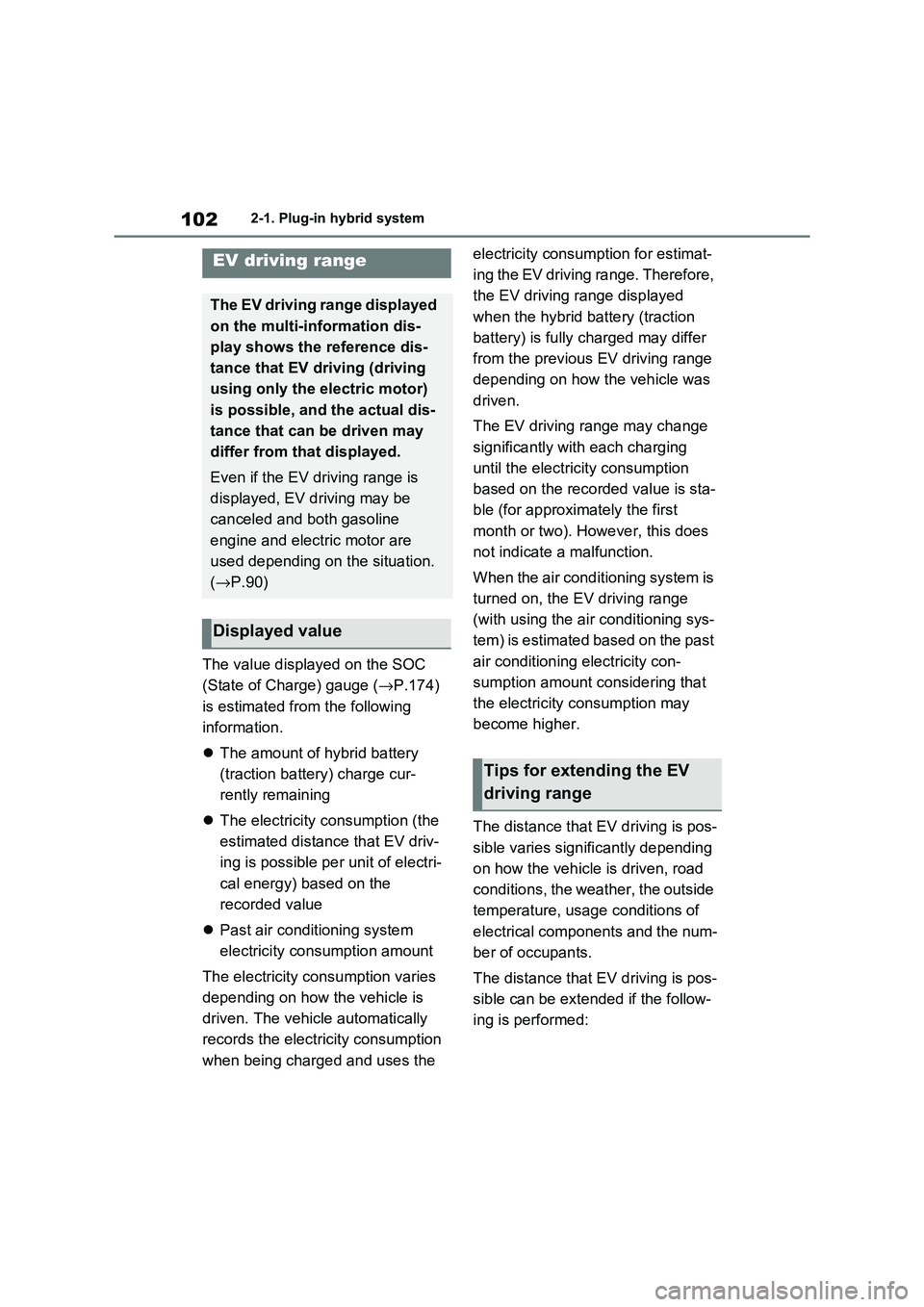
1022-1. Plug-in hybrid system
The value displayed on the SOC
(State of Charge) gauge ( →P.174)
is estimated from the following
information.
The amount of hybrid battery
(traction battery) charge cur -
rently remaining
The electricity consumption (the
estimated distan ce that EV driv-
ing is possible pe r unit of electri-
cal energy) based on the
recorded value
Past air conditioning system
electricity consumption amount
The electricity co nsumption varies
depending on how the vehicle is
driven. The vehicle automatically
records the electricity consumption
when being charged and uses the
electricity consumption for estimat -
ing the EV driving range. Therefore,
the EV driving ra nge displayed
when the hybrid battery (traction
battery) is fully charged may differ
from the previous EV driving range
depending on how the vehicle was
driven.
The EV driving r ange may change
significantly with each charging
until the electricity consumption
based on the recorded value is sta -
ble (for approximately the first
month or two). However, this does
not indicate a malfunction.
When the air conditioning system is
turned on, the EV driving range
(with using the air conditioning sys -
tem) is estimated based on the past
air conditioning electricity con -
sumption amount considering that
the electricity consumption may
become higher.
The distance that EV driving is pos -
sible varies signi ficantly depending
on how the vehicle is driven, road
conditions, the weather, the outside
temperature, usage conditions of
electrical components and the num -
ber of occupants.
The distance that EV driving is pos -
sible can be extended if the follow -
ing is performed:
EV driving range
The EV driving range displayed
on the multi-information dis -
play shows the reference dis -
tance that EV driving (driving
using only the electric motor)
is possible, and the actual dis-
tance that can be driven may
differ from that displayed.
Even if the EV dr iving range is
displayed, EV driving may be
canceled and both gasoline
engine and electric motor are
used depending on the situation.
( →P.90)
Displayed value
Tips for extending the EV
driving range
Page 129 of 666
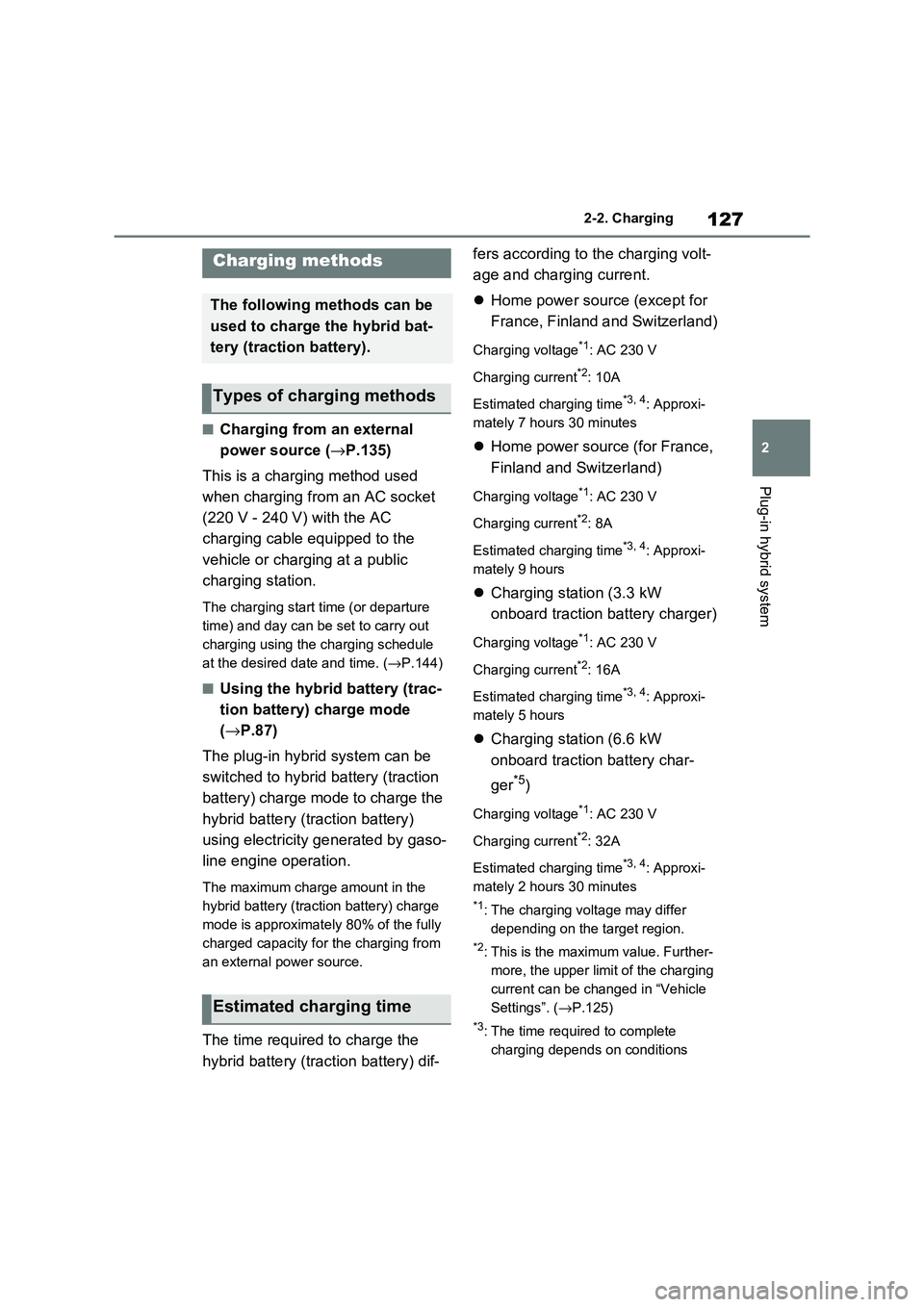
127
2
2-2. Charging
Plug-in hybrid system
■Charging from an external
power source ( →P.135)
This is a charging method used
when charging from an AC socket
(220 V - 240 V) with the AC
charging cable equipped to the
vehicle or charging at a public
charging station.
The charging start time (or departure
time) and day can be set to carry out
charging using the charging schedule
at the desired date and time. ( →P.144)
■Using the hybrid battery (trac-
tion battery) charge mode
( →P.87)
The plug-in hybrid system can be
switched to hybrid battery (traction
battery) charge mode to charge the
hybrid battery (traction battery)
using electricity generated by gaso-
line engine operation.
The maximum charge amount in the
hybrid battery (traction battery) charge
mode is approximately 80% of the fully
charged capacity for the charging from
an external power source.
The time required to charge the
hybrid battery (traction battery) dif -
fers according to t he charging volt-
age and charging current.
Home power source (except for
France, Finland and Switzerland)
Charging voltage*1: AC 230 V
Charging current*2: 10A
Estimated charging time*3, 4: Approxi -
mately 7 hours 30 minutes
Home power source (for France,
Finland and Switzerland)
Charging voltage*1: AC 230 V
Charging current*2: 8A
Estimated charging time*3, 4: Approxi -
mately 9 hours
Charging station (3.3 kW
onboard traction battery charger)
Charging voltage*1: AC 230 V
Charging current*2: 16A
Estimated charging time*3, 4: Approxi -
mately 5 hours
Charging station (6.6 kW
onboard traction battery char -
ger*5)
Charging voltage*1: AC 230 V
Charging current*2: 32A
Estimated charging time*3, 4: Approxi -
mately 2 hours 30 minutes
*1: The charging voltage may differ
depending on the target region.
*2: This is the maximum value. Further -
more, the upper limit of the charging
current can be changed in “Vehicle
Settings”. ( →P.125)
*3: The time required to complete
charging depends on conditions
Charging methods
The following methods can be
used to charge the hybrid bat -
tery (traction battery).
Types of charging methods
Estimated charging time
Page 172 of 666
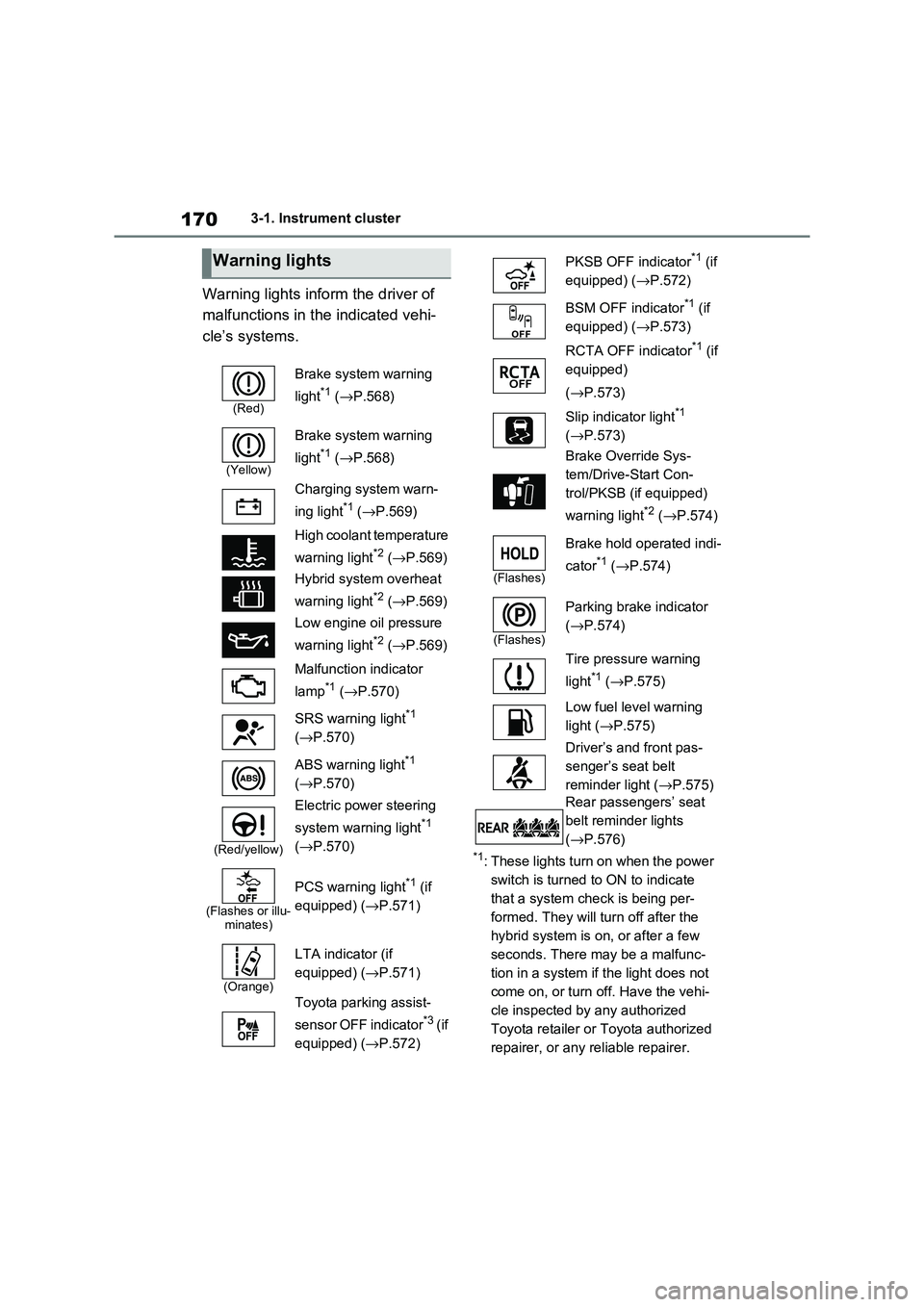
1703-1. Instrument cluster
Warning lights inform the driver of
malfunctions in the indicated vehi -
cle’s systems.
*1: These lights turn on when the power
switch is turned to ON to indicate
that a system check is being per -
formed. They will turn off after the
hybrid system is on , or after a few
seconds. There may be a malfunc-
tion in a system if the light does not
come on, or turn off. Have the vehi -
cle inspected by any authorized
Toyota retailer or Toyota authorized
repairer, or any reliable repairer.
Warning lights
(Red)
Brake system warning
light*1 ( →P.568)
(Yellow)
Brake system warning
light*1 ( →P.568)
Charging system warn -
ing light*1 ( →P.569)
High coolant temperature
warning light*2 ( →P.569)
Hybrid system overheat
warning light*2 ( →P.569)
Low engine oil pressure
warning light*2 ( →P.569)
Malfunction indicator
lamp*1 ( →P.570)
SRS warning light*1
( →P.570)
ABS warning light*1
( →P.570)
(Red/yellow)
Electric power steering
system warning light*1
( →P.570)
(Flashes or illu- minates)
PCS warning light*1 (if
equipped) ( →P.571)
(Orange)
LTA indicator (if
equipped) ( →P.571)
Toyota parking assist-
sensor OFF indicator*3 ( i f
equipped) ( →P.572)
PKSB OFF indicator*1 (if
equipped) ( →P.572)
BSM OFF indicator*1 (if
equipped) ( →P.573)
RCTA OFF indicator*1 (if
equipped)
( →P.573)
Slip indicator light*1
( →P.573)
Brake Override Sys -
tem/Drive-Start Con -
trol/PKSB (if equipped)
warning light*2 ( →P.574)
(Flashes)
Brake hold operated indi-
cator*1 ( →P.574)
(Flashes)
Parking brake indicator
( →P.574)
Tire pressure warning
light*1 ( →P.575)
Low fuel level warning
light ( →P.575)
Driver’s and front pas -
senger’s seat belt
reminder light ( →P.575)
Rear passengers’ seat
belt reminder lights
( →P.576)
Page 179 of 666
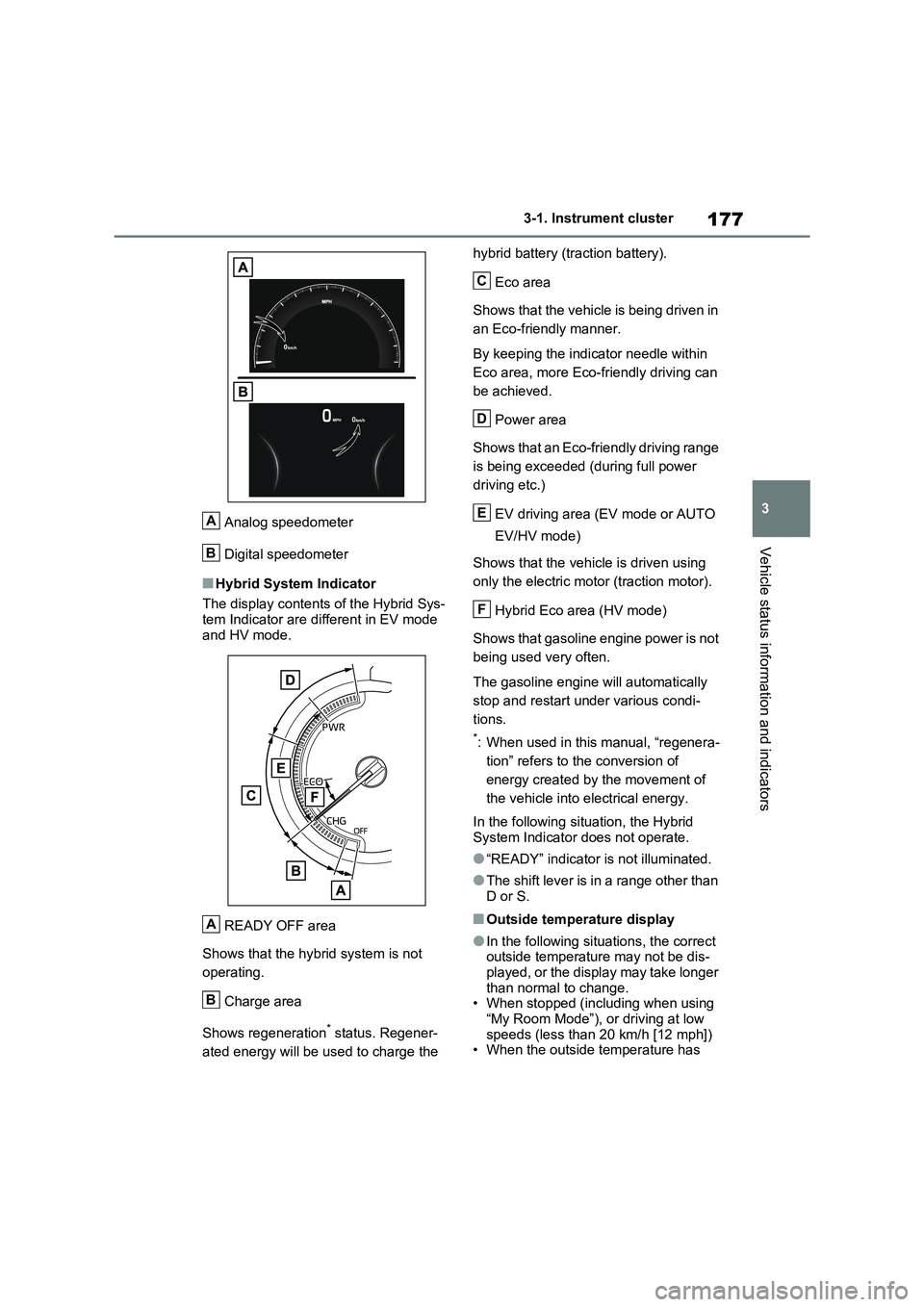
177
3
3-1. Instrument cluster
Vehicle status information and indicators
Analog speedometer
Digital speedometer
■Hybrid System Indicator
The display contents of the Hybrid Sys -
tem Indicator are di fferent in EV mode
and HV mode.
READY OFF area
Shows that the hybrid system is not
operating.
Charge area
Shows regeneration* status. Regener -
ated energy will be us ed to charge the
hybrid battery (traction battery).
Eco area
Shows that the vehicle is being driven in
an Eco-friendly manner.
By keeping the indicator needle within
Eco area, more Eco-f riendly driving can
be achieved.
Power area
Shows that an Eco-friendly driving range
is being exceeded (during full power
driving etc.)
EV driving area (EV mode or AUTO
EV/HV mode)
Shows that the vehicle is driven using
only the electric moto r (traction motor).
Hybrid Eco area (HV mode)
Shows that gasoline engine power is not
being used very often.
The gasoline engine will automatically
stop and restart under various condi -
tions.
*: When used in this manual, “regenera -
tion” refers to the conversion of
energy created by the movement of
the vehicle into electrical energy.
In the following sit uation, the Hybrid
System Indicator does not operate.
●“READY” indicator is not illuminated.
●The shift lever is in a range other than D or S.
■Outside temperature display
●In the following situ ations, the correct outside temperature may not be dis -
played, or the display may take longer
than normal to change. • When stopped (including when using
“My Room Mode”), o r driving at low
speeds (less than 2 0 km/h [12 mph]) • When the outside temperature has
A
B
A
B
C
D
E
F
Page 180 of 666
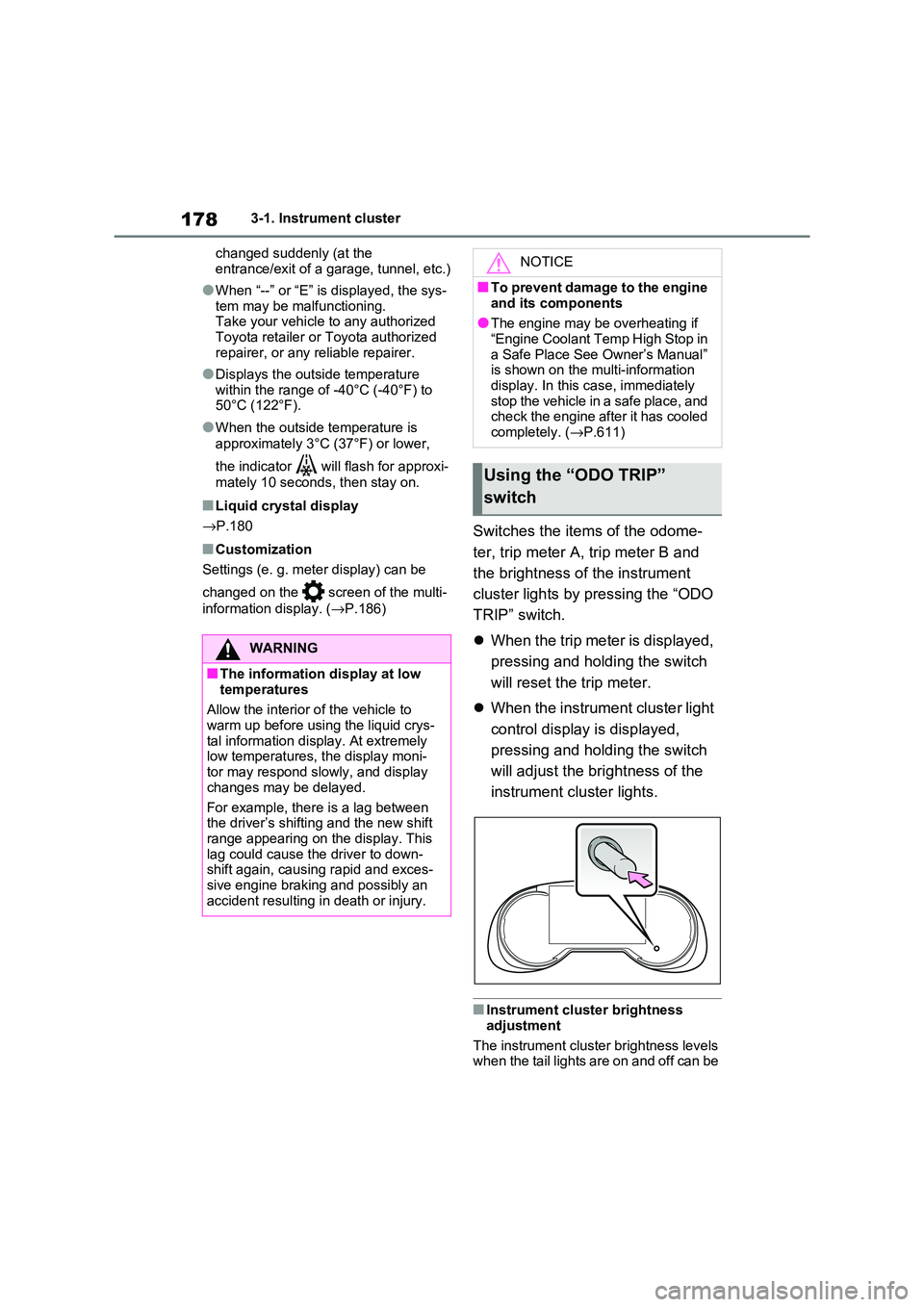
1783-1. Instrument cluster
changed suddenly (at the
entrance/exit of a garage, tunnel, etc.)
●When “--” or “E” is displayed, the sys -
tem may be malfunctioning. Take your vehicle to any authorized
Toyota retailer or Toyota authorized
repairer, or any reliable repairer.
●Displays the outsi de temperature
within the range o f -40°C (-40°F) to 50°C (122°F).
●When the outside temperature is
approximately 3°C (37°F) or lower,
the indicator will flash for approxi-
mately 10 seconds, then stay on.
■Liquid crystal display
→ P.180
■Customization
Settings (e. g. mete r display) can be
changed on the scre en of the multi-
information display. ( →P.186)
Switches the items of the odome-
ter, trip meter A, trip meter B and
the brightness of the instrument
cluster lights by pressing the “ODO
TRIP” switch.
When the trip meter is displayed,
pressing and holding the switch
will reset the tr ip meter.
When the instrument cluster light
control display is displayed,
pressing and holding the switch
will adjust the brightness of the
instrument cluster lights.
■Instrument cluster brightness
adjustment
The instrument cluster brightness levels when the tail lights are on and off can be
WARNING
■The information display at low
temperatures
Allow the interior o f the vehicle to
warm up before usin g the liquid crys-
tal information display. At extremely low temperatures, the display moni -
tor may respond slowly, and display
changes may be delayed.
For example, there is a lag between
the driver’s shifting and the new shift
range appearing on the display. This lag could cause the driver to down -
shift again, causing rapid and exces -
sive engine braking and possibly an accident resulting in death or injury.
NOTICE
■To prevent damage to the engine
and its components
●The engine may be overheating if “Engine Coolant Temp High Stop in
a Safe Place See Owner’s Manual”
is shown on the multi-information display. In this case, immediately
stop the vehicle in a safe place, and
check the engine after it has cooled
completely. ( →P.611)
Using the “ODO TRIP”
switch